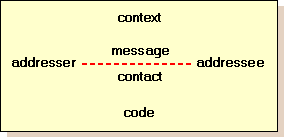Lesson 11: Encoding/Decoding
Jakobson's Communication Model
"what is 'meant' is invariably more than what is 'said' "
Contemporary semioticians refer to the creation and interpretation of texts as 'encoding' and 'decoding' respectively.
In the context of semiotics, 'decoding' involves not simply basic recognition and comprehension of what a text 'says' but also the interpretation and evaluation of its meaning with reference to relevant codes.
A distinction is made between comprehension and interpretation; what is 'meant' is invariably more than what is 'said' (Smith 1988, Olson 1994).
Roman Jakobson's model
of interpersonal verbal communication - 1960 (drawing on work by Bьhler dating from the 1930s)

The addresser sends a message to the addressee. To be operative the
message requires a context referred to ('referent' in another,
somewhat ambivalent, nomenclature), seizable by the addressee, and either
verbal or capable of being verbalized, a code fully, or at least
partially, common to the addresser and addressee (or in other words, to the
encoder and decoder of the message); and finally, a contact, a
physical channel and psychological connection between the addresser and the
addressee, enabling both of them to stay in communication.
(Jakobson 1960, 353)
Roman Jakobson's six 'constitutive factors... in any act of verbal communication':
Jakobson proposed that 'each of these six factors determines a different function of language' (Jakobson 1960, 353):
| Type
| Oriented towards
| Function
| Example
|
| referential
| context
| imparting information
| It's raining.
|
| expressive
| addresser
| expressing feelings or attitudes
|
|
| conative
| addressee
| influencing behaviour
|
|
| phatic
| contact
| establishing or maintaining social relationships
|
|
| metalingual
| code
| referring to the nature of the interaction (e.g. genre)
|
|
| poetic
| message
| foregrounding textual features
|
|
Class assignment (group work, done orally):
1. Fill in the last column of the table above with the following sentences (the first one has been done for you):
- This is the weather forecast.
- It's bloody pissing down again!
- Nasty weather again, isn't it?
- It droppeth as the gentle rain from heaven.
- Wait here till it stops raining!
2. Invent you own situation and describe it in 6 sentences each illustrating one of the factors shown in the table.
|
Resources for Lesson 11:
Chandler, Daniel. Semiotics for Beginners.
Hall, Stuart ([1973] 1980): 'Encoding/decoding'. In Centre for Contemporary Cultural Studies (Ed.): Culture, Media, Language: Working Papers in Cultural Studies, 1972-79 London: Hutchinson, pp. 128-38
Corner, John (1983): 'Textuality, Communication and Power'. In Davis, Howard & Paul Walton (Eds.) (1983a): Language, Image, Media. Oxford: Basil Blackwell, pp. 266-81
Eco, Umberto (1965): 'Towards a Semiotic Enquiry into the Television Message', In Corner & Hawthorn (Eds.) (1980), pp. 131-50
Eco, Umberto (1981): The Role of the Reader. London: Hutchinson
Smith, Frank (1988): Understanding Reading. Hillsdale, NJ: Erlbaum
Olson, David (1994): The World on Paper: The Conceptual and Cognitive Implications of Writing and Reading. Cambridge: Cambridge University Press
Jakobson, Roman (1960): 'Closing Statement: Linguistics and Poetics'. in Sebeok, Thomas A (Ed.) (1960): Style in Language. Cambridge, MA: MIT Press, , pp. 350-77
Foucault, Michel (1970): The Order of Things. London: Tavistock
http://www.sjsu.edu/faculty/wooda/171/171syllabus4chapter2.html
http://www.fanpop.com/spots/ugly-betty/articles/15640
Myers, Kathy (1983): 'Understanding Advertisers'. In Davis, Howard & Paul Walton (Eds.) (1983): Language, Image, Media. Oxford: Basil Blackwell , pp. 205-223
|
Пермский государственный университет
|